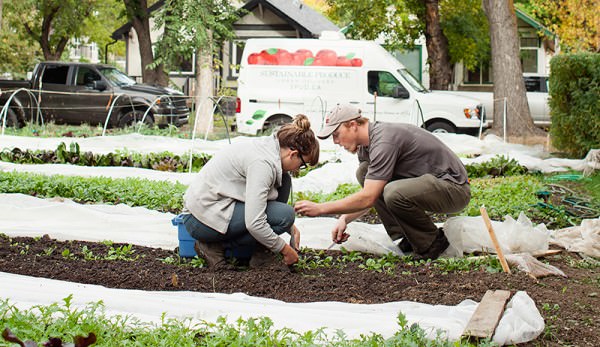
While there is a growing number of people interested in the concept of growing food for themselves or to sell, becoming a farmer who manages large fields out in the country is often seen as a completely other story. Although at first glance rural-based farmers and city-based farmers don’t appear to have much in common, many urban farmers, like Ryan Mason and Cathryn Sprague of Edmonton, Alberta, contend that they’re legit farmers, too.
“Cathryn and I met at university, both doing a Master’s degree in Environmental Sociology,” Mason says. “We had multiple discussions in class and outside about food security in Canada and globally, and about how we could contribute and how systems could be improved in different ways. … Then, we decided we would be interested in trying to start up some sort of organization to affect food systems in some way. One of the most logical steps was to look at SPIN farming.”
SPIN stands for Small Plot Intensive Agriculture. The idea is to use land—typically urban infill areas—as efficiently as possible. In those conversations just over two years ago, Sprague and Mason began planning a city farm that would be financially sustainable and produce a lot of food. They called it Reclaim Urban Farm.
Working For The Farm
Before the operation even got started, Mason and Sprague put a lot of time and effort into marketing. They began by writing newsletter columns and articles, putting them in about a dozen local publications. This garnered quite a bit of attention within the community.
“We also went and looked for vacant lots specifically and other places with good exposure, and tried to find out who owned that land to gain access to it,” Mason says. “In our first year, through those two methods, we found eight parcels of land, including our biggest one today, which is a vacant lot close to about a fifth of an acre.”
Not So Fast
It didn’t take long for bigger media to hear about their project and get word out about it. And as the growing season started, Sprague and Mason found their email flooded with land offers. They started the year off with 15 pieces of land, including the original eight parcels, but after their first year’s experience, it was clear that managing 15 locations may be too much to handle. Plus, some of the locations did not have the best sunlight or had limited water accessibility.
“Then, we went and looked for larger parcels to try to increase our economy of scale to try to make it more efficient, and we found two other large vacant lots,” Mason says. “So we had fewer spaces but more land the second year. Now, that’s kind of our strategy. We go and look for vacant lots and focus on those spaces for summer growing.”
Reclaim Urban Farm has developed a winter revenue stream, as well, working out of the warehouse that a local organic grocery store uses, growing a vertical garden and trays of microgreens and herbs that they sell directly to restaurants and customers.
“It’s essentially shelving units that have fluorescent lights on them,” Mason explains. “We sell about half of them to consumers through farmers markets.”
Planning Equals Success
While planning is the key to success in most endeavours, it’s especially true in the case of intensive farming.
“Because we only have about an acre of land, we have to maximize the amount of space continually to be financially feasible,” Mason says. “Growing high-value crops based on square footage, not on how much the crop sells for—things like baby greens—you’re getting more per square foot.
“This is on things we could get more money on one sale, but is also based on the amount of time they are in the field, so we can get multiple successions. Our baby greens have become one of our most popular and common products. We grow about 50 percent of our land in greens. They are in the ground as short as three weeks or as long as five weeks, and that means we can get four to six succession plantings and maximize the space.”
Having a well-defined and varied marketing strategy has been one of Reclaim Urban Farm’s main success stories, creating close to zero waste. Instead of selling to only restaurants or only farmers markets or only a CSA, they have diversified their marketing plan to incorporate all three simultaneously.
As for the landowners, they mainly crop-share with them, giving vegetables for the use of the land and water access.
Moving To The Country?
While Mason and Sprague have received land offers to farm outside of the city, it is not something they are looking to explore at the moment. However, Mason feels their operation has been a great stepping stone to being successful on a larger scale.
“I think urban farming can be a stepping stone for young farmers wanting to first access knowledge and experience about farming, and then going into either buying, renting, or sharing land with somebody outside the city center,” Mason says.
“But, I think another important use for urban farming is that, through its accessibility and visibility, it can create excitement in agriculture that can hopefully inspire and mentor young farmers wanting that experience without starting their own urban farm—allowing them the knowledge, skill sets, experience and everything they need before investing in a farm to learn to do these things. It’s almost like an incubator for farm wannabes to give them exposure before they break out into their own farm, whether that’s rural or urban.”
To learn more about Mason and Sprague’s work at Reclaim Urban Farm, visit their website.




